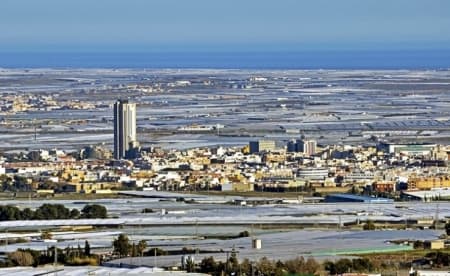
Greenhouse Farming
Adding to the cultural, geographical and gastronomic diversity of the Poniente of Almeria, it also possesses the largest surface of greenhouses in the world, specifically in the “Campo de Dalias”, also known as "The sea of plastic".
It is a region in which intensive agriculture is carried out, which allows a high technical and economic performance, leading to the development of a business system that generates jobs and a high Gross value added (GVA).
The main products of this type of agriculture in the Poniente of Almeria are: cucumbers, watermelons, eggplants, zucchinis, peaches, peppers and tomatoes. As for the latter, in the greenhouses of Almeria the exquisite Raf tomato is grown, which is a variety of tomato that is characterized by its particular flavor and textura. It is also great extra to add to to saline waters.

The first greenhouse in the Poniente of Almeria was built in 1963, as part of an investigation carried out by the National Institute of Colonization. This was done in order to compare the crops grown in the outdoors with crops in greenhouses.
The results were amazing, both in the productive performance and in the incomes seen. Tomatoes, peppers and cucumbers, from that first greenhouse crop, were larger in quantity, and in addition to that, were being sold at higher prices than those grown outdoors.
The results were amazing, both in the productive performance and in the incomes seen. Tomatoes, peppers and cucumbers, from that first greenhouse crop, were larger in quantity, and in addition to that, were being sold at higher prices than those grown outdoors.
The use of plastic intensifies the sun's rays and at the same time maintains humidity, which favors crops, allowing them to be harvested in less time than in the open field. This means that more crops can be obtained per year than those obtained in outdoor crops.
The greenhouse is a structure that protects the crop which, combined with the good climate of Almeria (3,000 hours of sunshine per year), allows for healthy and abundant crops to grow. They do not suffer the negative consequences of winds and cold weather.
This productive model allows for the saving of water, a renewable natural resource that is increasingly scarce in the world. Not done in vain, this type of agriculture is at the forefront in the world efficient use of water resources, consuming only half of the water used by the rest of agriculture in Spain. This is done despite the fact that it is the most important fruit and vegetable producing area in the world.
Additionally, another reason its environmental sustainability stands out is due its energy saving and lower waste generation, improving the environmental behavior. Being the the pioneers of greenhouse crops in Almeria , you will also see the use of biological control of pests, where natural depredations such as fungi and bacteria are used.
Before the start of the greenhouse agriculture project, the southeast of Spain was one of the most depressed areas from an economic and social point of view. Since its inhabitants had to emigrate in order to survive, life changed radically with the arrival of intensive agriculture.

Greenhouse agriculture has become a type of family farming that evolves into the formation of Agricultural Cooperatives.
This allows a greater distribution of wealth, becoming the most redistributive agricultural system in Spain.
This system is a source of direct and indirect jobs, highlighting that it is beneficial for people at risk of exclusion (over 45 years of age and unskilled labor) and who can perform perfectly in the sector of fruit and vegetables.
This allows a greater distribution of wealth, becoming the most redistributive agricultural system in Spain.
This system is a source of direct and indirect jobs, highlighting that it is beneficial for people at risk of exclusion (over 45 years of age and unskilled labor) and who can perform perfectly in the sector of fruit and vegetables.














